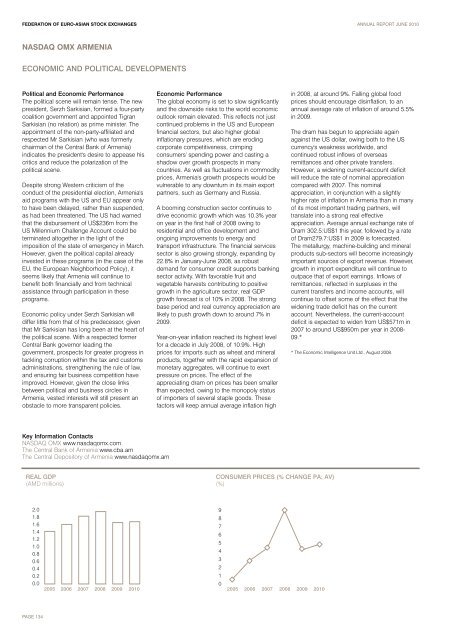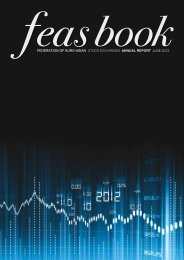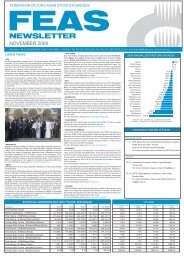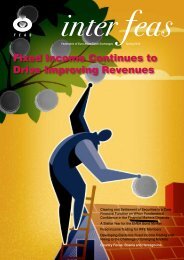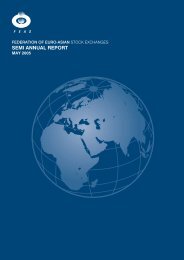Download - FEAS
Download - FEAS
Download - FEAS
- No tags were found...
Create successful ePaper yourself
Turn your PDF publications into a flip-book with our unique Google optimized e-Paper software.
FEDERATION OF EURO-ASIAN STOCK EXCHANGES ANNUAL REPORT JUNE 2010NASDAQ OMX ARMENIAECONOMIC AND POLITICAL DEVELOPMENTSPolitical and Economic PerformanceThe political scene will remain tense. The newpresident, Serzh Sarkisian, formed a four-partycoalition government and appointed TigranSarkisian (no relation) as prime minister. Theappointment of the non-party-affiliated andrespected Mr Sarkisian (who was formerlychairman of the Central Bank of Armenia)indicates the president's desire to appease hiscritics and reduce the polarization of thepolitical scene.Despite strong Western criticism of theconduct of the presidential election, Armenia'said programs with the US and EU appear onlyto have been delayed, rather than suspended,as had been threatened. The US had warnedthat the disbursement of US$236m from theUS Millennium Challenge Account could beterminated altogether in the light of theimposition of the state of emergency in March.However, given the political capital alreadyinvested in these programs (in the case of theEU, the European Neighborhood Policy), itseems likely that Armenia will continue tobenefit both financially and from technicalassistance through participation in theseprograms.Economic policy under Serzh Sarkisian willdiffer little from that of his predecessor, giventhat Mr Sarkisian has long been at the heart ofthe political scene. With a respected formerCentral Bank governor leading thegovernment, prospects for greater progress intackling corruption within the tax and customsadministrations, strengthening the rule of law,and ensuring fair business competition haveimproved. However, given the close linksbetween political and business circles inArmenia, vested interests will still present anobstacle to more transparent policies.Economic PerformanceThe global economy is set to slow significantlyand the downside risks to the world economicoutlook remain elevated. This reflects not justcontinued problems in the US and Europeanfinancial sectors, but also higher globalinflationary pressures, which are erodingcorporate competitiveness, crimpingconsumers' spending power and casting ashadow over growth prospects in manycountries. As well as fluctuations in commodityprices, Armenia's growth prospects would bevulnerable to any downturn in its main exportpartners, such as Germany and Russia.A booming construction sector continues todrive economic growth which was 10.3% yearon year in the first half of 2008 owing toresidential and office development andongoing improvements to energy andtransport infrastructure. The financial servicessector is also growing strongly, expanding by22.8% in January-June 2008, as robustdemand for consumer credit supports bankingsector activity. With favorable fruit andvegetable harvests contributing to positivegrowth in the agriculture sector, real GDPgrowth forecast is of 10% in 2008. The strongbase period and real currency appreciation arelikely to push growth down to around 7% in2009.Year-on-year inflation reached its highest levelfor a decade in July 2008, of 10.9%. Highprices for imports such as wheat and mineralproducts, together with the rapid expansion ofmonetary aggregates, will continue to exertpressure on prices. The effect of theappreciating dram on prices has been smallerthan expected, owing to the monopoly statusof importers of several staple goods. Thesefactors will keep annual average inflation highin 2008, at around 9%. Falling global foodprices should encourage disinflation, to anannual average rate of inflation of around 5.5%in 2009.The dram has begun to appreciate againagainst the US dollar, owing both to the UScurrency's weakness worldwide, andcontinued robust inflows of overseasremittances and other private transfers.However, a widening current-account deficitwill reduce the rate of nominal appreciationcompared with 2007. This nominalappreciation, in conjunction with a slightlyhigher rate of inflation in Armenia than in manyof its most important trading partners, willtranslate into a strong real effectiveappreciation. Average annual exchange rate ofDram 302.5:US$1 this year, followed by a rateof Dram279.7:US$1 in 2009 is forecasted.The metallurgy, machine-building and mineralproducts sub-sectors will become increasinglyimportant sources of export revenue. However,growth in import expenditure will continue tooutpace that of export earnings. Inflows ofremittances, reflected in surpluses in thecurrent transfers and income accounts, willcontinue to offset some of the effect that thewidening trade deficit has on the currentaccount. Nevertheless, the current-accountdeficit is expected to widen from US$571m in2007 to around US$950m per year in 2008-09.** The Economic Intelligence Unit Ltd., August 2008.Key Information ContactsNASDAQ OMX www.nasdaqomx.comThe Central Bank of Armenia www.cba.amThe Central Depository of Armenia www.nasdaqomx.amREAL GDP(AMD millions)CONSUMER PRICES (% CHANGE PA; AV)(%)2.01.81.61.41.21.00.80.60.40.20.098765432102005 2006 2007 2008 2009 2010 2005 2006 2007 2008 2009 2010PAGE 134


